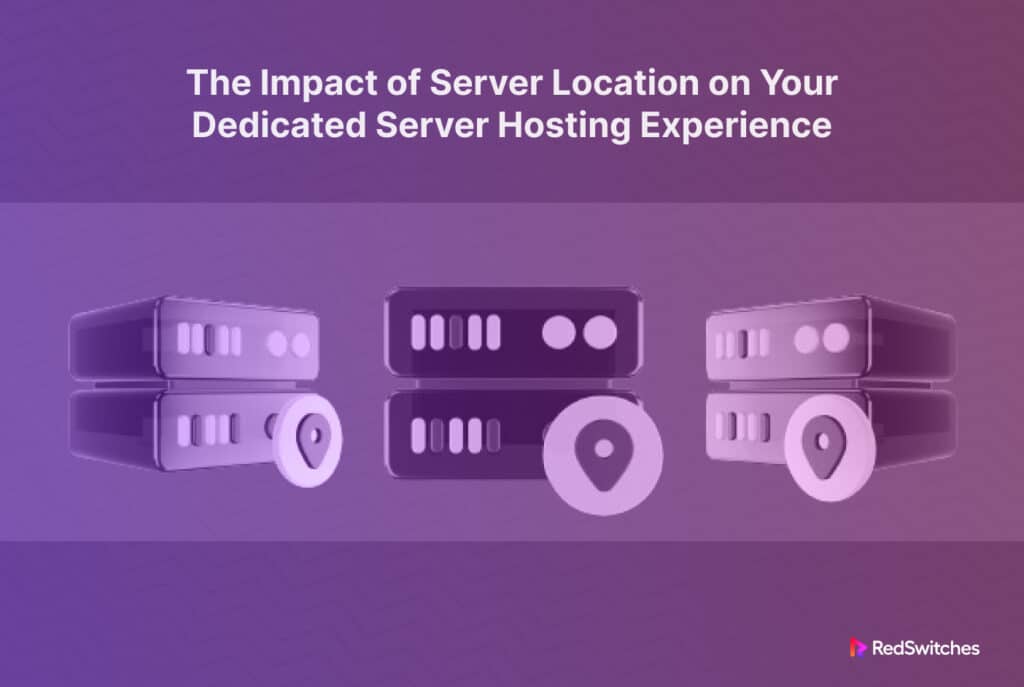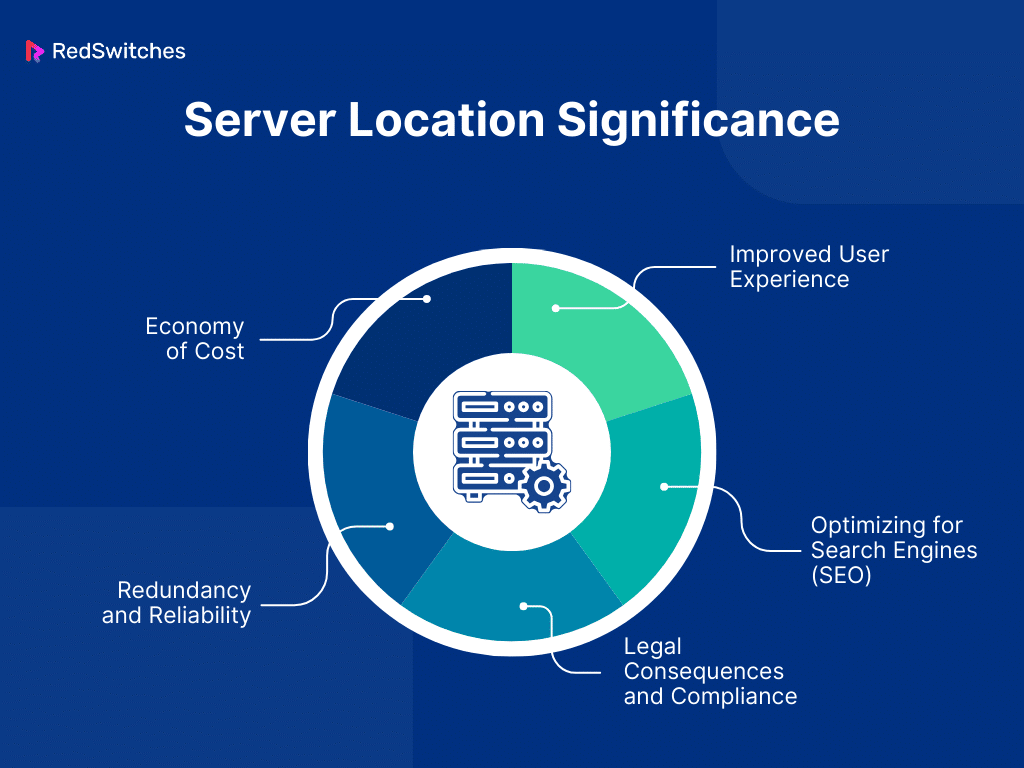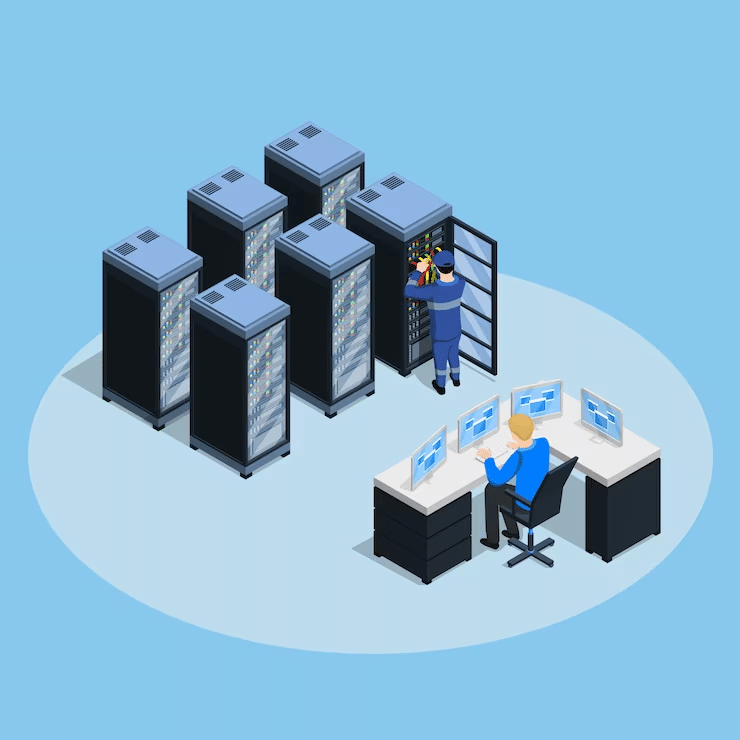Key Takeaways
- The closer a server is to its users, the lower the latency, resulting in faster page loads and a smoother online experience.
- A server’s location can significantly influence local SEO efforts, making websites more likely to appear in local search results.
- Data protection and privacy laws vary by region. Hosting servers in locations that comply with these regulations is vital for legal operations and maintaining customer trust.
- Geographic redundancy and disaster recovery planning are essential for maintaining high availability and service continuity.
- Choosing server locations strategically can mitigate risks related to natural disasters and infrastructure failures.
- Datacenter costs vary based on location, affecting energy, cooling, and real estate expenses.
- Optimal server placement can offer significant savings, contributing to more cost-effective hosting solutions.
- The rise of cloud computing, edge computing, AI, and 5G networks is shifting how businesses approach server location.
- Ultimately, the strategic location of servers can lead to better user experiences, higher SEO rankings, compliance with legal standards, and cost savings.
The role of server location in dedicated server hosting is a critical aspect often overlooked in the search for optimal performance and efficiency. As businesses increasingly rely on digital platforms to drive growth and connectivity, the physical location of their servers emerges as a crucial factor in shaping their online experience.
Server location highlights as the hidden hero of web performance. This article explores the critical impact of location of your server. It can improve your website’s speed, dependability, and SEO rankings. We’ll guide you through server location nuances using sharp analysis and pro guidance. Plus, you will also get to know how a smart choice can boost your online presence.
Come along as we explore the vital connection between geography and technology. We will reveal key tactics to maximize your Dedicated Server Experience.
Table of Contents
- Key Takeaways
- What is the Server Location?
- Server Location Significance
- Impact of Server Location on Performance and User Experience
- SEO Considerations for Server Location
- Legal and Privacy Issues in Location of Server
- Reliability and Uptime on Server Location
- Emerging Technologies and Their Impact on Server Location Decisions
- Conclusion
- FAQs
What is the Server Location?
Credits: Freepik
The actual location of the data center where a server is housed is referred to as the server location. This location can significantly impact websites and apps. It affects them in many ways, including speed, latency, and accessibility for users in different places. Optimizing online experiences in dedicated server hosting requires a deep awareness. You must understand the subtleties of server placement.
Despite the internet’s seeming worldwide reach, the idea of server placement is grounded in the real world. From the server, data must pass via some networks and infrastructures before the end user can access it. The latency amount—the time it takes for this data to travel—depends on the user’s distance from the server. A server closer to the intended audience can guarantee faster access times, lower latency, and a more seamless user experience.
Additionally, server location affects privacy, legal issues, speed, and efficiency. Laws of data protection, privacy, and content filtering differ across nations. Hosting your server in a place that meets these requirements can help keep compliance and avoid legal problems. Picking a server location that follows local laws is critical. It’s needed for legal operations and for keeping client trust. This is true for firms that target customers in specific regions.
Server Location Significance
In web hosting and online services, server location is more than just technical. It is a strategic element. It directly affects efficiency, obeying rules, and user experience. The specifics show how server placement affects any entity’s online presence. The effects are complex.
Improved User Experience
The user experience is one of the most direct consequences of server placement, primarily due to lower latency. Latency is the time data goes from the server to the user’s device. It dramatically affects how quickly websites load and how responsive online apps are. This travel time can be significantly reduced by using a nearer server. This leads to faster page loading and smoother interaction. This speed is essential for keeping users interested, decreasing bounce rates, and extending their time on the site—it’s not just a convenience. A competitive advantage can be gained by optimizing speed through server location at a time when users demand instantaneous responses.
Optimizing for Search Engines (SEO)
Search engine optimization (SEO) relies heavily on the server’s location. Search engines aim to deliver the most relevant results to users; a portion of this relevancy is based on the content’s geographic relevance. Search engines might consider a website more relevant for local queries if it is hosted on a server in the exact location of its target audience. Higher rankings in search results may follow, bringing in more natural visitors to the website. The location becomes a crucial component of a server SEO strategy for companies that target particular geographic areas.
Legal Consequences and Compliance
Credits: Freepik
Data security and privacy are critical in today’s digital environment. The General Data Protection Regulation (GDPR) of the European Union is one example of the various laws and regulations that regulate data privacy in different nations and areas. Hosting a server in a location compliant with these standards is essential to guarantee compliance and steer clear of any possible legal problems. Furthermore, several nations have limitations on the kinds of content that can be hosted or viewed inside their boundaries. Organizations must manage a delicate balance when choosing a server location that meets operational needs and maneuvers through these legal difficulties.
Redundancy and Reliability
The placement of servers also impacts the redundancy and dependability of web hosting services. Data centers in areas with stable infrastructure, little chance of natural disasters, and robust connectivity provide higher uptime and dependability. Moreover, redundancy can be improved by strategically placing servers across some locations, preventing a full-service outage in the event of a server or location failure. Planning server locations with various locations across different regions helps protect against unanticipated circumstances and guarantees ongoing online service availability.
Economy of Cost
The impact of server location has a big effect on how cost-effective it is. A data center’s location can impact the operational expenses of hosting services, such as energy costs, cooling requirements, and real estate values. For example, data centers in milder regions could have reduced cooling expenses since the surrounding environment helps servers dissipate heat. This can result in significant energy bill savings, increasing the viability of hosting services at such sites.
Furthermore, real estate prices vary significantly throughout geographical areas. In locations with fewer land and building expenses, hosting companies might pass these savings on to their customers through cheaper hosting prices. On the other hand, because their overhead is higher, data centers located in expensive cities may charge more for their services.
Also Read, How to Check Server Location? A Step-By-Step Guide.
Impact of Server Location on Performance and User Experience
Credits: Freepik
The server’s location greatly affects dedicated server hosting, especially latency. Latency affects user experience, server speed, and site loading times. Maintaining an effective, user-friendly online presence that satisfies the demands of modern internet users requires these elements.
The Impact of Latency on User Experience
The time lag before a data transmission starts in response to a transfer command is called latency. In essence, it measures how long it takes for a data packet to transit between the user’s device and the server. The user’s geographical distance from the server is an essential factor in determining this delay. A slow user experience may result from increasing latency, which increases with the distance the data must travel.
High latency impacts all facets of user engagement with a website or online application. Every activity, including filling out forms, clicking links, and loading multimedia, has a waiting period.
Site Load times and Server Speed
The speed at which a server responds to requests is known as its server speed, which is closely linked to latency. This speed determines the user’s overall experience with site loading times and latency. A server’s hardware and software can impact its speed. But, its location impacts the internet’s data speed.
Site loading speeds are also a major component of SEO effectiveness. Faster websites have a higher chance of ranking higher in search results. Search engines like Google consider page speed when ranking. Selecting a server location is crucial for search engine visibility and user experience.
Effects on Users of Mobile Devices
The widespread use of mobile internet further highlights the significance of server placement. Different network circumstances that mobile users frequently experience can make latency problems worse. A server closer to the users might lessen these variations. It would ensure a more responsive and steady experience. This would be true across various devices and network scenarios. This is crucial for companies trying to reach rising mobile internet users. For them, speed and performance are even more critical. This is because of the limits of mobile networks.
Networks for Delivering Content (CDNs)
One tactical solution to the problems caused by server placement is the deployment of Content Delivery Networks or CDNs. CDNs deliver content to consumers more effectively. They do this by caching it at edge servers closer to them. CDNs are networks of servers positioned throughout the globe. The CDN can considerably cut latency by serving content from a closer server. It can also speed up site loading times. This is true even if the core server is far from the end-user. CDN services are a scalable option for companies reaching a global audience. They emphasize the crucial role of geographic proximity in improving online performance.
Effect on Local Targeting and International SEO
The server’s location affects search engine optimization (SEO). SEO is customized for different regions for organizations that do business internationally. Search engines may use the server’s location when evaluating material’s relevance to specific regions or languages. It is a signal for geo-targeting. Thus, a website can have better access to local audiences by being more visible in local search results when hosted on a server within the target region.
User Experience and Rates of Conversion
In the end, the total effect of server location on speed, latency, and dependability results in observable changes in business metrics and user behavior. Smooth, fast-loading websites increase user engagement, lower bounce rates, and promote longer browsing sessions. Whether completing a contact form, purchasing, or subscribing to a newsletter is the desired action, these favorable user experiences are directly associated with more excellent conversion rates.
Let’s summarize it in a tabular format.
SEO Considerations for Server Location
Credits: Freepik
Server Location and Local SEO
The main goal of local SEO is to optimize a website to appear in local search results. Businesses that service certain geographic areas or have a physical presence should pay special attention to this. For several reasons, the server’s physical location can be critical to local SEO efforts.
Geo-Targeting Signals: Search engines use various signals to assess a website’s applicability to particular geographical areas. Among these indications is the location of the server. Search engines may be more likely to prominently display a website’s content in local search results if it is hosted on a server in or close to the target region.
Site Speed and User Experience: As previously mentioned, server location impacts them. Google, in particular, uses page speed as a ranking factor for search engines. A server closer to the target audience can improve user experience, speed up page loads, and lower latency, boosting SEO rankings.
Localized Content Delivery: The server’s location can help users in the target region access localized content more quickly and consistently. This enhances the user experience while supporting search engines’ objective of giving people access to the most relevant content according to location.
Improved Mobile Optimization: The significance of mobile optimization for search engine optimization (SEO) cannot be emphasized, especially with the rise in the popularity of mobile searches, especially for local services and companies. Faster page loads on mobile devices are primarily attributed to a server location that minimizes latency for the bulk of mobile users in a target area. This is important because cellular networks, which might be slower or more inconsistent in speed than wired connections, are frequently used by mobile users. Businesses can enhance the performance of their mobile sites, which is essential for mobile SEO, by ensuring the server is located closer to the target audience.
Enhanced Local User Engagement and Interaction: A well-chosen server location can boost local user engagement and interaction. Local consumers are more likely to connect with content on websites that load quickly and function well, share the content on social media, and otherwise engage with the site in ways that indicate its relevance and quality to search engines. This includes contributing to local forums or discussions held on the website and writing reviews and comments.
Effect on the Ranking of Search Engines
Enhancing a website’s visibility in search engine results pages (SERPs) is the main objective of SEO. Through its impact on user experience and geo-targeting signals, server location indirectly influences this goal; however, its influence also extends to broader considerations:
Global Presence vs. Global Reach: Server placement might be a problem for companies that want to reach a worldwide clientele. Although local hosting can help with local SEO, it might not be as helpful for a global audience. Content Delivery Networks (CDNs) provide a solution that compromises local presence and worldwide reach in this situation. Content Delivery Networks (CDNs) ensure that users get websites from servers that are geographically close to them by caching content on servers worldwide. This keeps users’ experiences positive and loading times quick for various geographical locations.
The Synergy between TLD and Server Location: A top-level domain’s (TLD) selection might enhance server location for SEO purposes. Search engines receive strong indications regarding the relevancy of a .uk domain housed on a UK-based server for UK-based searches.
Connecting Patterns and Local Relevance: The natural connecting pattern pointing to your website may vary depending on the server location. Search engines will see websites housed in a particular region more relevant to their location if they are more likely to obtain backlinks from other websites in the same region.
Legal and Privacy Issues in Location of Server
Credits: Freepik
The placement of servers raises key legal and privacy concerns. This is especially true in a world where digital data crosses borders in milliseconds. Online firms must be aware of these issues and navigate the complex waters of server location, data protection laws, and privacy.
Laws and Rules Governing Data Protection
Businesses that operate internationally need help. This is due to the vast differences in data privacy rules across jurisdictions. These regulations place stringent restrictions on collecting, processing, storing, and transferring personal data to safeguard its integrity and confidentiality.
The General Data Protection Regulation (GDPR):
It is arguably the most well-known law. It applies to companies operating inside and outside the European Union that handle the data of EU citizens. This mandates strict data protection rules. It also mandates permission procedures for data gathering. And, it mandates individual rights to access and manage data. Organizations must consider server locations. The locations must help them follow GDPR standards. Not doing so can result in heavy fines.
California Consumer Privacy Act (CCPA):
The CCPA affects companies that gather data from California residents and gives customers in California certain rights over their personal information, similar to the GDPR. These rights include being informed about the data being collected, having personal information deleted, and choosing not to have their personal information sold.
Other Regional Laws:
Many regions and nations have passed data protection laws. For example, there is the LGPD in Brazil and PIPEDA in Canada. Every legal system has unique criteria that affect where to place servers and how to process data.
Privacy Issues and the Location of the Server
Different nations have varied rules on surveillance and data access. So, server placement affects not just performance and compliance. It also raises serious privacy concerns.
Data requests and Government Surveillance:
In many legal systems, governments have much power to monitor and get information on their land. They may be subject to more intrusive data access or surveillance than in their native country. This may be a privacy concern for them. You can reduce these dangers by picking a server location in a nation with strong data protection laws. It should also have less surveillance.
Jurisdictional Difficulties:
The legal rules for requests to access data, including those by law enforcement, depend on the jurisdiction where the data is kept. Companies must be very careful when navigating these seas. They must ensure that their server’s location complies with privacy laws and have procedures for handling requests for data access.
Reliability and Uptime on Server Location
Credits: Freepik
Server location, reliability, and uptime are critical. They affect users’ trust and the consistency of online services. Network infrastructure, geographic redundancy, disaster recovery planning, and connection are essential components for high availability and resilience.
Disaster Recovery and Geographic Redundancy
Geographic Redundancy:
Putting duplicate data and web services in many places is called geographic redundancy. Businesses can ensure that if a malfunction, disaster, or other surprise hits one location, the service can continue from another. They can spread resources across many data centers in different regions. This will cause minimal to no downtime for end users. A crucial tactic is to keep high availability and ensure business continuity.
Disaster Recovery:
Planning for disaster recovery explains how an organization would resume operations in the case of a catastrophic occurrence. It is closely related to geographic redundancy. Servers are in places vulnerable to natural disasters. These places include flood zones and earthquake-prone areas. They raise the risk of data loss and service outages. So, server location is critical in disaster recovery planning. Suitable disaster recovery methods are based on choosing low-risk server sites. You should also deploy backup servers in different zones. This plan covers the logistics of how fast the service can be restored after a disruption. It also covers the locations of the servers.
Network Connectivity and Infrastructure
Connectivity:
The dependability and performance of the server rely heavily on its connectivity to the broader internet, including the number of upstream providers and internet exchange points (IXPs). Servers are housed in data centers. They have direct access to significant IXPs, many redundant internet connections, and lower latency. They can provide faster speeds and increased resilience against network outages. This is because having many paths for data enables automatic rerouting if one fails. This guarantees the service’s availability.
Infrastructure:
The network infrastructure’s caliber, resilience, and capacity around a data center significantly impact server uptime and dependability. This covers the software programs that control data flow in the network and the hardware, which includes switches, routers, and cabling. These data centers have more robust networks, more considerable bandwidth, and better connectivity options. You find them in areas with more developed technology. Ensuring data transmission is reliable and efficient lowers the chance of malfunctions or bottlenecks, which could cause downtime.
Also Read, The Importance of Data Center Location in Dedicated Server Hosting.
Emerging Technologies and Their Impact on Server Location Decisions
New technologies significantly impact how data centers and server hosting are managed, and these changes are ongoing. They change how companies choose where to put servers. They now consider more than just the standard variables: cost, performance, and regulation. New technologies like artificial intelligence (AI), edge computing, cloud computing, and 5G networks are leading this shift.
Cloud-Based Software
Cloud computing has completely changed how data is processed and stored. It does this by providing scalable, adaptable, and effective online solutions. Cloud services are widely available. So, companies may install their apps in cloud data centers worldwide. This lessens the need for physical server sites. They can choose server locations based on needs. They do not need to invest in physical infrastructure in those areas. For example, they can be close to users for lower latency or in areas with favorable regulations.
Cutting-Edge Computing
Edge computing is a revolutionary approach to network architecture. It is especially relevant in the age of real-time analytics, mobile computing, and the Internet of Things. Edge computing helps process data made by devices and sensors. It does this closer to the point of creation. It moves data processing away from transferring it over long distances to data centers or clouds. This closeness dramatically reduces latency. It helps applications needing real-time or near-real-time operations. These include autonomous vehicles, smart cities, and remote medicine. Also, edge computing’s layout improves data security and privacy by processing and storing data locally. It does this by minimizing the exposure of sensitive data.
Machine learning and Artificial Intelligence
Incorporating AI and machine learning into data center operations and server location strategy is not only beneficial. It is also more and more required. It is needed to maximize efficiency and predict future needs. These technologies provide intelligent insights. They do this by sifting through data to find patterns, predict outcomes, and automate decision-making. AI can predict traffic spikes. It can adjust resources to stay fast. Or, it might find hardware issues early, reducing downtime. AI is used in cloud environments to manage workloads across international networks. It ensures that apps run on the best servers based on conditions and demand.
5G Networks
5G networks offer high-speed, low-latency communication. They surpass previous generations’ capabilities. So, their global implementation is poised to transform connectivity. This advance will enable a new generation of mobile services and apps. They will range from huge IoT installations and critical communications to better mobile broadband. 5G significantly impacts server location because it makes it possible to provide content and apps in a more scattered manner, bringing the cloud closer to the user and opening the door for edge computing to thrive. The growth of 5G also incentivizes investments in edge infrastructure as businesses strive to leverage the network’s full capabilities, indicating a shift towards a more fluid, responsive, and user-centric model of internet services.
Also Read, Navigating the Future of Dedicated Server Hosting Market.
Conclusion
In summary, the server’s location greatly affects all your dedicated server hosting aspects. This includes data privacy, legal compliance, latency, and SEO. New technologies, like cloud computing, edge computing, AI, and 5G, show the crucial need for well-placed servers. The location of servers is a key investment in a company’s digital future. It’s not just a technical one. This is especially true for companies that want to maximize their online visibility.
Recognizing the evolving demands of server location, RedSwitches positions itself as a leader in providing server hosting. We consider these complications and understand them well. Our focus is to optimize your hosting experience for today and tomorrow. With a focus on high performance, adaptability, and compliance, Redswitches offers the infrastructure to turn your digital goals into reality.
RedSwitches is your reliable partner in navigating the complexities of server location to secure a competitive edge in the digital era. Ready to elevate your server experience? Get in touch with RedSwitches today and let us customize a hosting solution that moves your business forward.
FAQs
Q. What is an example of a server network?
A dedicated server network, such as the servers utilized by a sizable online service or a corporate intranet, is a network infrastructure in which servers are assigned solely to a single customer or organization.
Q. Why choose a server?
A dedicated server can be customized to match individual company demands and offers improved performance, security, and control over the server environment.
Q. Is the cloud a server?
The cloud is a virtual server network that shares real hardware, providing scalable and adaptable resources as needed. It is not the same as a server.
Q. What is server hosting?
Server hosting is a solution where a client leases an entire server for their exclusive use. This gives them complete control over server resources and allows for greater customization.
Q. How does a server differ from shared hosting?
In shared hosting, multiple websites share the same server resources, while in server hosting, the entire server is dedicated to one client. This results in higher performance and reliability for dedicated server users.
Q. What are the benefits of using a server?
A Server provides more security measures, better performance, and allows for greater customization compared to shared hosting or VPS solutions. It also offers complete control over server configuration and management.
Q. Can I use a server for gaming purposes?
Yes, servers are commonly used for hosting gaming servers. They provide the necessary resources and performance to ensure a smooth gaming experience for players.
Q. How important is server management for dedicated hosting?
Server management is crucial for dedicated hosting as it involves configuring the server, ensuring optimal performance, and implementing security measures. Managed dedicated hosting services often include technical support for server management.
Q. How can I upgrade to a server from another hosting solution?
To upgrade to a server, you can contact a hosting provider offering dedicated hosting services. They will assist you in migrating your website or application to the new server and configuring it according to your needs.
Q. What factors should I consider when choosing the right server?
When choosing a server, consider factors such as the type of hosting you need, server resources required, security measures in place, and the level of technical support provided. It is important to select a server that meets your specific requirements.










